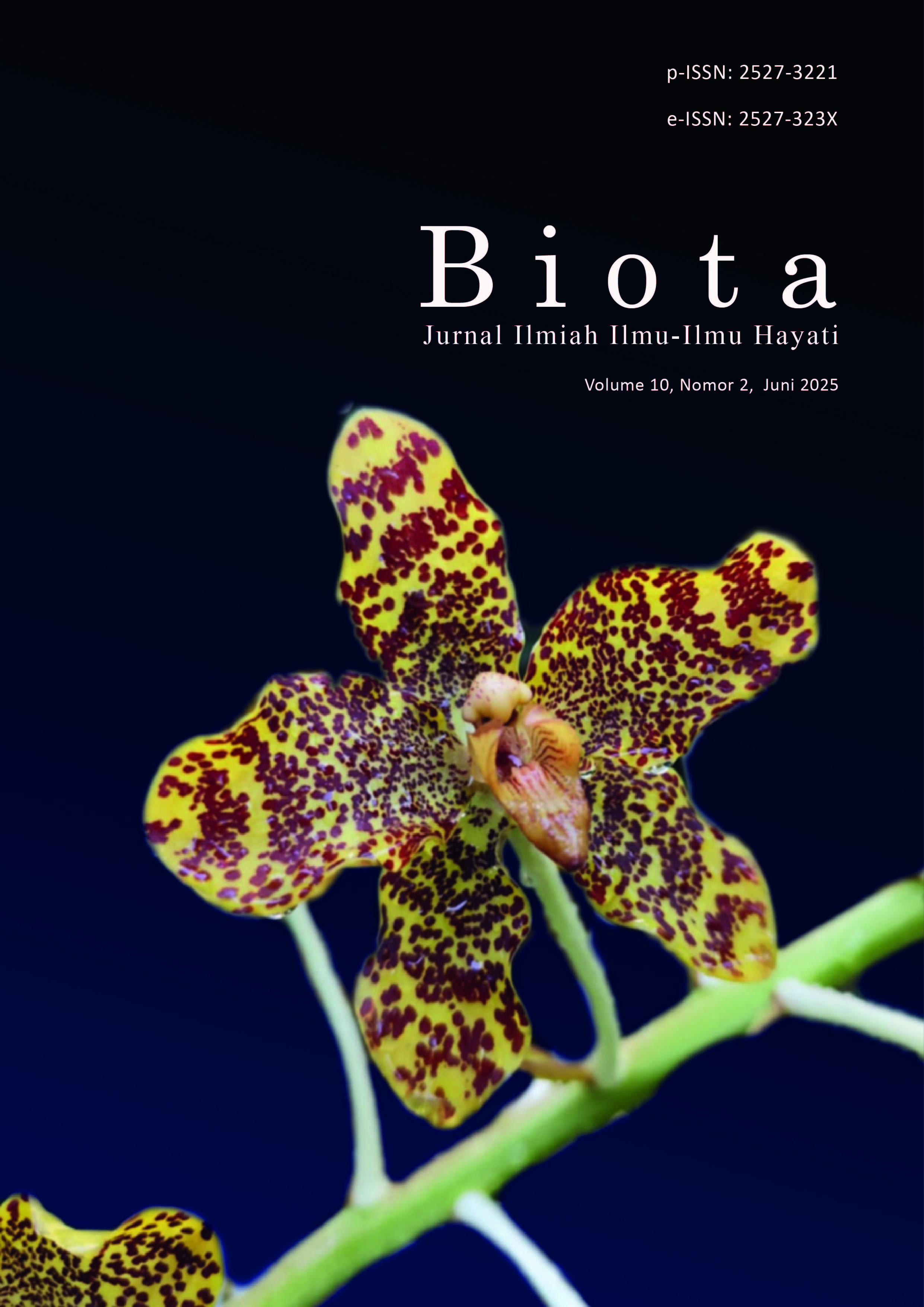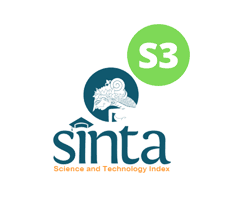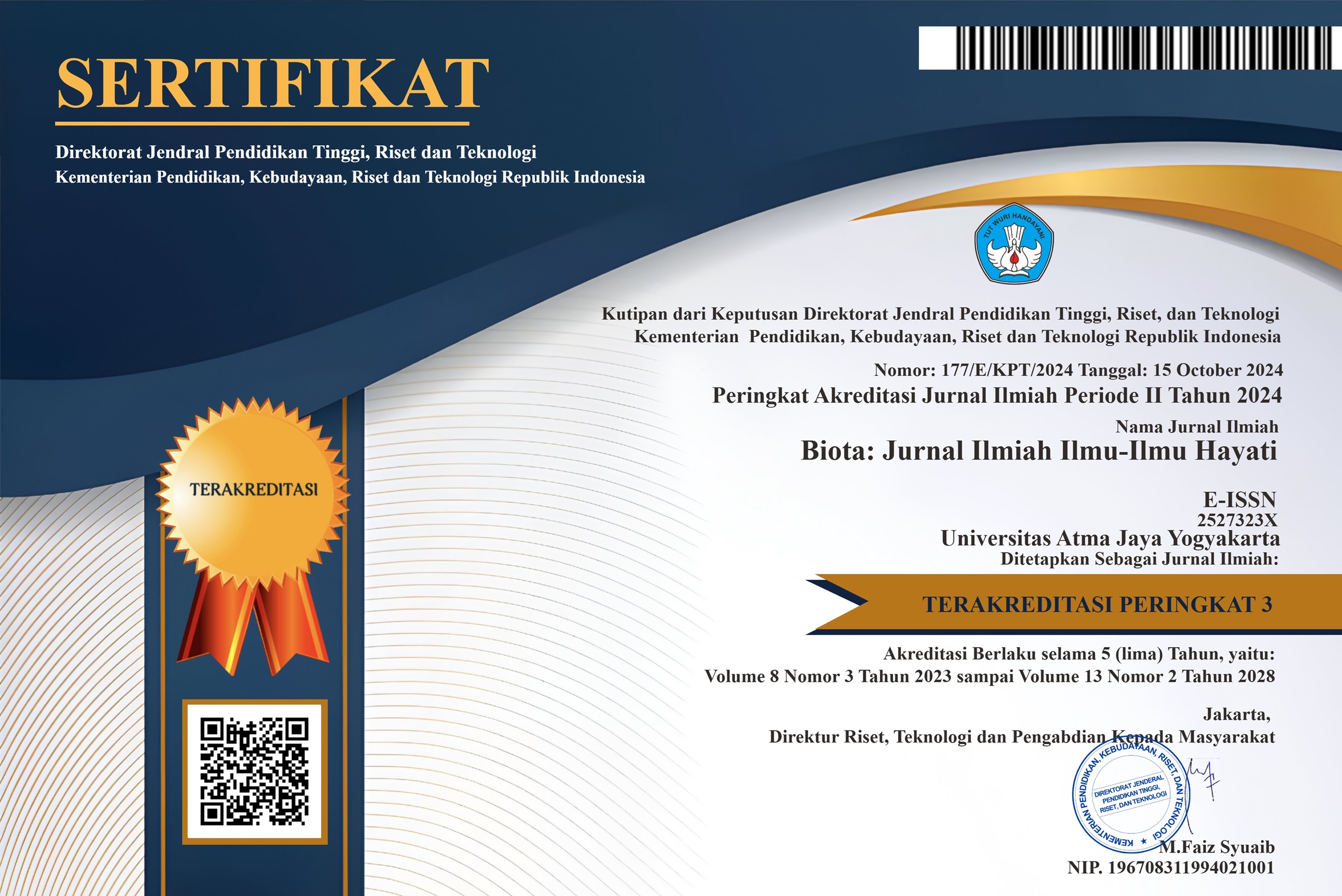Natural Dye as an Alternative to Hematoxylin-Eosin Staining on Histological Preparations
DOI:
https://doi.org/10.24002/biota.v10i2.7909Keywords:
Hibiscus sabdariffa, Lawsona inermis, Lonchocarpus cyanescens, natural dyes, Syzygium cuminiAbstract
Hematoxylin-eosin is widely utilized in the field of animal microtechniques. However, the need to develop alternative dyes from natural sources such as plants has gained attention. Several studies have shown that many plants contain secondary metabolites with the potential to be developed as natural dyes. Lonchocarpus cyanescens and Syzygium cumini are promising candidates as alternative dyes for hematoxylin, while Lawsonia inermis and Hibiscus sabdariffa have shown potential as substitute dyes for eosin. These plants contain various secondary metabolites, including anthocyanins, flavonoids, chlorophyll, betalains, alkaloids, saponins, tannins, carbohydrates, proteins, phenolics, terpenoids, quinones, coumarins, xanthones, and resins. L. cyanescens exhibits a strong binding affinity to cells and tissues, particularly testicular tissue. Dyes derived from Syzygium cumini have been shown to provide a good staining result for rat liver cells. In contrast, dyes from Lawsonia inermis can stain cytoplasmic components and muscle fibers. Additionally, the dye from Hibiscus sabdariffa is capable of staining various biological components, including sperm, nerve cells, and blood cells. The dye preparation process involved extraction from different plant organs, such as leaves, flowers, and fruit. These findings suggest that secondary metabolites from these four plants hold significant potential for development as natural dyes to replace hematoxylin-eosin in histological applications.
References
Adisa, J. O., Musa, K. K., Egbujo, E. C. & Uwaeme, I. M. (2017). A study of various modifications of Lawsonia inermis (henna) leaf extract as a cytoplasmic stain in liver biopsies. International Journal of Research in Medical Sciences 5 (3): 1058-1065.
Affat, S. S. (2021). Classifications, advantages, disadvantages, toxicity effects of natural and synthetic dyes: a review. University of Thi-Qar Journal of Sciences (UTsci) 8(1): 130-135.
Agbede, M. B., Benard, S. A. I., Afolabi, O. O., Okoye, J. O., Bankole, J. K., Fowotade, A. A. 1., Olutunde, O. A. & Muhammed, O. A. (2017). The use of Hibiscus sabdariffa extract as a nuclear stain for skin morphology and connective tissue with eosin counterstain. Sokoto Journal of Medical Laboratory Science 2(4): 28-32.
Alkhamiss, A. S. (2020). Evaluation of better staining method among hematoxylin and eosin, giemsa and periodic acid schiff-alcian blue for the detection of Helicobacter pylori in gastric biopsies. The Malaysian Journal of Medical Sciences 27(5): 53-61.
Amit, T. A. & Luis A. C. (2023). Exploring natural dye and bioactive secondary metabolites in Lonchocarpus cyanescens benth (Fabaceae) plant using liquid chromatography-high-resolution mass spectrometry and compound discoverertm software. ChemRxiv Journal 1(1): 1-37.
Anzani, S. D. W., Pulungan, M. H. & Lutfi, S. R. (2016). Pewarna alami daun sirsak (Annona muricata L.) untuk kain mori primissima (kajian: kenis dan konsentrasi fiksasi). Industria: Jurnal Teknologi dan Manajemen Agroindustri 5(3): 132-139.
Asra. R., Gita. H. & Zulharmita. (2021). Utilization of natural dyes substances for histological staining: a review. Asian Journal of Pharmaceutical Research and Development 9(1): 149-158.
Asyah, S., Nailufar, Y., & Astuti, T. D. (2024). Literature review: red dragon fruit (Hylocereus costaricensis) as an alternative stain to hematoxylin-eosin in histology preparation making. Menara Journal of Health Science 3(1): 220-228.
Babili, F. E., Valentin, A. & Chatelain, C. (2013). Lawsonia inermis: its anatomy and its antimalarial, antioxidant, and human breast cancer cells MCF7 activities. Pharmaceut Anal Acta 4(1): 2153-2435.
Bassey, R. B., Airat, A. B., Innocent, A. E., Abraham, A. A. O., Ademola, A. O., (2012). Staining characteristics of Lonchocarpus cyanescens leaf extract on the testis of Sprague-Dawley rats. Microscopy and Microanalysis 18(4): 840-843.
Chan, J. K. C. (2014). The Wonderful colors of the hematoxylin-eosin stain in diagnostic surgical pathology. International Journal of Surgical Pathology 22 (1): 12-32.
Eman, A. H. (2006). The use of the watery extract of Gujarat flowers Hibiscus sabdariffa as a natural histological stain. Iraqi Journal of Medical Sciences 5(1): 29-33.
Hartika, G., Zulharmita. & Asra, R. (2021). Utilization of natural dyes substances for histological staining. Asian Journal of Pharmaceutical Research and Development 9(1): 149-158.
HistoWiz, Inc. (2024). When to Choose IHC over H&E Staining: A Comprehensive Guide, Retrieved January 19, 2025, from https://home.histowiz.com/blog/IHC-H&E/
Hong, S. D., Dhong, H. J., Chung, S. K., Kim, H. Y., Park, J. O. & Ha, S. Y. (2014). Hematoxylin and eosin staining for detecting biofilms: practical and cost-effective methods for predicting worse outcomes after endoscopic sinus surgery. Clinical and Experimental Otorhinolaryngology 7(3): 193-197.
Irshad, H. (2014). Methods for nuclei detection, segmentation, and classification in digital histopathology: A review - Current Status and Future Potential. IEEE Reviews in Biomedical Engineering (7): 97 - 114.
Jabeur, I., Pereira, E., Barros, L., Calhelha, R. C., Soković, M., Oliveira, M. B. P. P., Ferreira, I. C. F. R. (2017). Hibiscus sabdariffa L. as a source of nutrients, bioactive compounds and colouring agents. Food Res Int 1(2): 717-723.
John, K. C. & Chan. (2014). The wonderful colors of the hematoxylin–eosin stain in diagnostic surgical pathology. International Journal of Surgical Pathology 22(1): 12-32.
Joshua, B. I., Ndam, K. S., Danjuma, G. D. & Gunya, D. Y. (2021). Assessing the use of Lawsonia inermis and Hibiscus sabdariffa aqueous extracts as a possible substitute for eosin stain in paraffin-embedded tissues. International Journal of Research in Medical Sciences 2(2): 5-12.
Kakkar, A., Ramalingam, K., Agarwal, M., Tyagi, V., Tanwar. M. & Bose, S. (2022). A comparative study of Ayoub-Scholar, Dane-Herman, alcian blue-Pas, rapid Papanicolaou stain, Gram's stains with hematoxylin-eosin stain for demonstration of keratin in paraffin-embedded tissue sections. International Journal of Early Childhood Special Education 14(3): 10419-10428.
Kawilarang. & Pohan, A. (2022). Perbandingan pewarnaan haematoxylin & eosin (HE) dan gomori methenamine silver-haematoxylin eosin (GMS-HE) pada beberapa jamur sistemik didalam Jaringan. Jurnal Mikologi Klinik dan Penyakit 1(22): 6-11.
Khassandra S. A., Angela, R. M., Jay, R. N., Renn, S. R., Shanel, T., Bryan, V. J., Ian, V. A., Gabrielle, V. D. & Rose, B. P. (2023). Evaluation of duhat (Syzygium cumini) leaves as cytological stain. Asian Journal of Biological and Life Sciences (12 (2): 378-385.
Korade, D., Lalita, S., Deepika, M. & Stem, M. (2014). Application of aqueous plant extracts as biological stains. International Journal of Scientific & Engineering Research 5(2): 1586-1589.
Kumar, R., Singh, N. P., Mukopadayay, S. & Sah, R. P. (2022). Ethnomedicinal and pharmacological properties of Hibiscus sabdariffa: a review. International Journal of Health Sciences 6(3): 9744–9758.
Mayangsari, M. A., Nuroini, F., & Ariyadi, T. (2019). Perbedaan kualitas preparat ginjal marmut pada proses deparafinasi menggunakan xylol dan munyak zaitun pada pewarnaan H&E. Prosiding pada Prosiding Mahasiswa Seminar Nasional Unimus (hlm. 190-194). Semarang, Indonesia.
Meenakshi, D., Saxena, D. S., Sundaragiri, D. K. S., Sankhla. D. B., Bhargava, D. A. & Rawat, D. M. (2021). A comparative cytological study of eosin & eco-friendly cytoplasmic stains pilot study. IOSR Journal of Dental and Medical Sciences (IOSR-JDMS) 20(4): 44-49.
Lab Best Practice Team, Department of Pathology and Laboratory Medicine, UC Davis Health. (2020). Staining Methods in Frozen Section: Best Lab Practices, Retrieved January 19, 2025, from https://health.ucdavis.edu
Nilgun, K. & Ferda, E. (2022). Applicability of alkanet (alkanna tinctoria) extract for the histological staining of liver tissue. Journal of the Indian Chemical Society 99(4): 100409.
Nurandriea, E., & Azmi, D. (2017). Ekstraksi zat warna alami dari kayu Secang (Caesalpinia sappan Linn) dengan Metode Ultrasound Assisted Extraction untuk aplikasi produk pangan. (Bachelor's thesis). Institut Teknologi Surabaya, Surabaya.
Obeta, U., Dajok, G., Ejinaka, O., Deko, B., Yususf, B. N., Ukpabi, M., Amunum, S., G. & Achagh, J. (2022). Beetroot and turmeric as alternative dyes for hematoxylin and eosin in histological staining. Scientific Research Journal of Clinical and Medical Sciences 2 (10): 54-58.
Onah, E., Offiaha, S. U., Chimea, U.K., Whytea, G. M., Obodoa, R. M., Ekechukwuf, O. V., Ahmadc, I., Ugwuokea, P. E. & Ezema, F (2020). Comparative photo-response performances of dye sensitized solar cells using dyes from selected plants. Surfaces and Interfaces Journal 1(1): 1-17.
Ozawa, A. & Sakaue, M. (2020). The new decolorization method produces more information from tissue sections stained with hematoxylin and eosin stain and Masson-trichrome stain. Annals of Anatomy 227: 151431.
Pujilestari, T. (2016). Sumber dan pemanfaatan zat warna alam untuk keperluan industri, dinamika kerajinan, dan batik. Majalah Ilmiah 32(2): 93-106.
Pratama, M.I., Rajun., Dahlan F, Anisa, N., Ningsih, I.N., Sari, K.Y.B., Pratiwi, S.S., & Putri, N.K., (2023). Potential of methanol E]extract from Rosella (Hibiscus sabdariffa) as an Alternative dye in gram staining. ICTROPS 3(1): 290-297.
Qu, A. P., Chen, J. M., Wang, L.W., Yuan, J. P., Yang, F., Xiang, Q. M., Maskey, N., Yang, G.F., Liu, J. & Li, Y. (2015). Segmentation of hematoxylin-eosin stained breast cancer histopathological images based on Pixel-Wise SVM classifier. Science China Information Sciences 58(4): 1-14.
Raju, L., Nambiar, S., Augustine, D., Sowmya S. V, Haragannavar, V. C., Babu, A. & Roopa S. R. (2018). Lawsonia inermis (Henna) extract: a possible natural substitute to eosin stain. Journal of Interdisciplinary Histopathology 6 (2): 54-60.
Saraswati. & Rahmawati, Y. (2023). Rosella (Hibiscus sabdariffa) sebagai alternatif bahan pewarna histologi. Jurnal Sains dan Teknologi Laboratorium Medik 9(1): 22-26.
Setadi, J. A., Dwihantoro, A., Iskandar, K., Heriyanto, D. S. & Gunadi. (2017). The utility of the hematoxylin and eosin staining in patients with suspected Hirschsprung disease. BMC Surg 17(21): 1-5.
Silvia, M. D., Rambe, A. Y. M., Simanjjuntak, A., Chrestella, J. & Ashar, T. (2017). Biofilm bakteri pada penderita rinosinusitis kronis: Laporan seri kasus berbasis bukti. Orli 47(2): 113-122.
Siregar, S., Krisdianilo, V. & Rizky, V. A. (2019). Efektifitas penggunaan pewarna alternatif preparat permanen telur nematoda kolon menggunakan pewarna Rhomadin B. Jurnal Farmasimed (JFM) 2(1): 31-39.
Sunarno, Mardiati, S. M. & Suprihatin, T. (2015). Potensi bahan antiaging dari ekstrak ikan gabus (Channa striata) terhadap perbaikan histo-morfologi hipokampus. Buletin Anatomi dan Fisiologi 23(1): 81-91.
Suvarna, S. K., Layton, C., & Bancroft, J. D. (2019). Bancroft’s theory and practice of histological techniques (8th ed.). Elsevier Health Sciences: Philadelphia.
Srivastava, B. D., Srivastava M., Urata, M., Suzuki, N. & Srivasta, A. K. (2020). Efficacy of jamun Syzygium cumini seed and orange Citrus sinensis peel extracts against microcystin LR induced histological damage in the kidney of rat. Brazilian Journal of Biological Sciences 7 (17): 247-259.
Syamsul, B. & Jalaluddin, R. (2017). Pembuatan zat warna alami dari kulit batang jamblang (Syzygium cumini) sebagai bahan dasar pewarna tekstil. Jurnal Teknologi Kimia Unimal 6(1): 10-19.
William, O. & Festus, A. (2013). Enhancing the value of indigo-blue dyes from Lonchocarpus cyanescens leaves. International Journal of Applied Science and Technology 3(5): 78-86.
Wulandari, F. Y. S., Widiyani, S. D. & Iswara. (2019). Caesar (Caesalpinia extract): pewarna alami tanaman Indonesia pengganti giemsa. Jurnal Labora Medika 3(2): 45-49.
Yeti, E. S. S. & Hariyanto. (2020). Rendaman kuncup daun jati (Tectona grandis) sebagai alternatif pewarna eosin pada proses histoteknik. Pada Prosiding Senakes (Vol. 1, No. 1, hlm. 93–106). Surabaya, Indonesia.
Zhang, L., Kong, H., Chin, C., T., Liu, S., Fan, X., Wang, T. & Chen, S. (2014). Automation-assisted cervical cancer screening in manual liquid-based cytology with hematoxylin and eosin staining. Journal of the International Society for Advancement of Cytometry 85(3): 214-230.
Zhang, W., Li, Y., Lin, J., Wan, S., Gao, H., Zhang, L., Zheng, J. & Zhang, P. (2013). Comparison of hematoxylin-eosin staining and methyl violet staining for displaying ghost cells. Eye Science 28(3): 140-143.
Wahyuni, S. (2015). Identifikasi preparat gosok tulang (bone) berdasarkan teknik pewarnaan. Peran Biologi dan Pendidikan Biologi dalam Menyiapkan Generasi Unggul dan Berdaya Saing Global. Prosiding pada Seminar Nasional Pendidikan Biologi 2015, Program Studi Pendidikan Biologi, FKIP Universitas Muhammadiyah Malang. Malang, Jawa Timur.
World Flora Online. (2022). Lonchocarpus cyanescens (Schumach. & Thonn.) Benth, Retrieved December 5, 2022, from http://www.worldfloraonline.org/taxon/wfo-0000199336
Downloads
Published
How to Cite
Issue
Section
License
Copyright (c) 2025 Ina Karlina, Nur Ainun Oktavia Pusparini, Chesa Ekani Maharesi, Faisal Saeed, Bambang Retnoaji, Hendry Saragih, Nur Indah Septriani, Zuliyati Rohmah, Susilo Hadi, Ardaning Nuriliani

This work is licensed under a Creative Commons Attribution-NonCommercial 4.0 International License.
Authors who publish with Biota : Jurnal Ilmiah Ilmu-Ilmu Hayati agree to the following terms:
- Authors retain copyright and grant the Biota : Jurnal Ilmiah Ilmu-Ilmu Hayati right of first publication. Licensed under a Creative Commons Attribution-NonCommercial 4.0 International License that allows others to share the work with an acknowledgment of the work's authorship and initial publication in this journal.
- Authors are able to enter into separate, additional contractual arrangements for the non-exclusive distribution of the journal's published version of the work (e.g., post it to an institutional repository or publish it in a book), with an acknowledgment of its initial publication in Biota : Jurnal Ilmiah Ilmu-Ilmu Hayati, and as long as Author is not used for commercial purposes.













